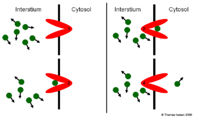Transport Proteins - Physiology
Diffusion Through Water Filled Protein Channels
Hydrophillic ions and molecules are unable to diffuse across the lipid bilayer. However if concentration gradients allow it they are sometimes able to diffuse across the membrane using water filled protein channels. These tend to be only large enough for small ions to pass through and so are perhaps more commonly known as ion channels. As well as concentration gradients, electrical gradients can cause the movement of ions. They tend to move towards areas of the charge opposite to themselves. The two factors of concentration and electrical are termed collectively as the electrochemical gradient and it is their combined effect which determines the movement of ions through channels. As the ions are moving down gradients this method of membrane transport is passive. The channels are usually specific to one or a few ions and can be opened and closed by the cell depending on what process ions are required for.
Facilitated Diffusion
Transport proteins allow hydrophillic molecules, which are too large to get through water filled protein channels, to passively cross the membrane. The molecules bind to protein and then the protein changes shape depositing the molecule at the other side of the membrane. This transport method is also known as Facilitated Diffusion. As with diffusion it occurs from areas of high concentration to those of low so is a passive process. This is unlike active transport which requires energy as it pushes molecules against their concentration gradient. However active transport does still use proteins
Differences Compared to Diffusion
- The proteins are very specific to very few molecules
- The proteins have a maximal rate. If the concentration of the molecule to be transported is very high the number of proteins is likely to limit the rate.
- Some of the proteins bind a small number of different molecules. These molecules will compete for the proteins and will be transported in similar relative quantities to their original concentrations.
ATPases
These proteins are enzymes which are catalysts for the decomposition of ATP to ADP + Pi. This releases energy which the protein utilises. The transmembrane ATPases are essential for transporting substances across membranes and play vital roles in both primary and secondary active transport. The main types of ATPase transporter are the co-transporters and the pumps. However some of the pumps are also technically co-transporters. If they cause a netflow of charge for example the sodium/potassium pump they are called electrogenic transporters. To be a true pump it needs to work by primary active transport and as a rule co-transporters work via secondary active transport.
Co-Transporters
This family of ATPase membrane proteins tend to be involved in secondary active transport. They bind two molecules and transport them across the membrane either in the same direction (symporter) or in opposite directions (antiporter). The potential energy derived from forcing one molecule across this allows the other co-transported molecule to be transported against its gradient.
Error in widget FBRecommend: unable to write file /var/www/wikivet.net/extensions/Widgets/compiled_templates/wrt6622be8c2154b3_44420761 Error in widget google+: unable to write file /var/www/wikivet.net/extensions/Widgets/compiled_templates/wrt6622be8c24ac97_15467097 Error in widget TwitterTweet: unable to write file /var/www/wikivet.net/extensions/Widgets/compiled_templates/wrt6622be8c27e578_41163832
|
| WikiVet® Introduction - Help WikiVet - Report a Problem |
